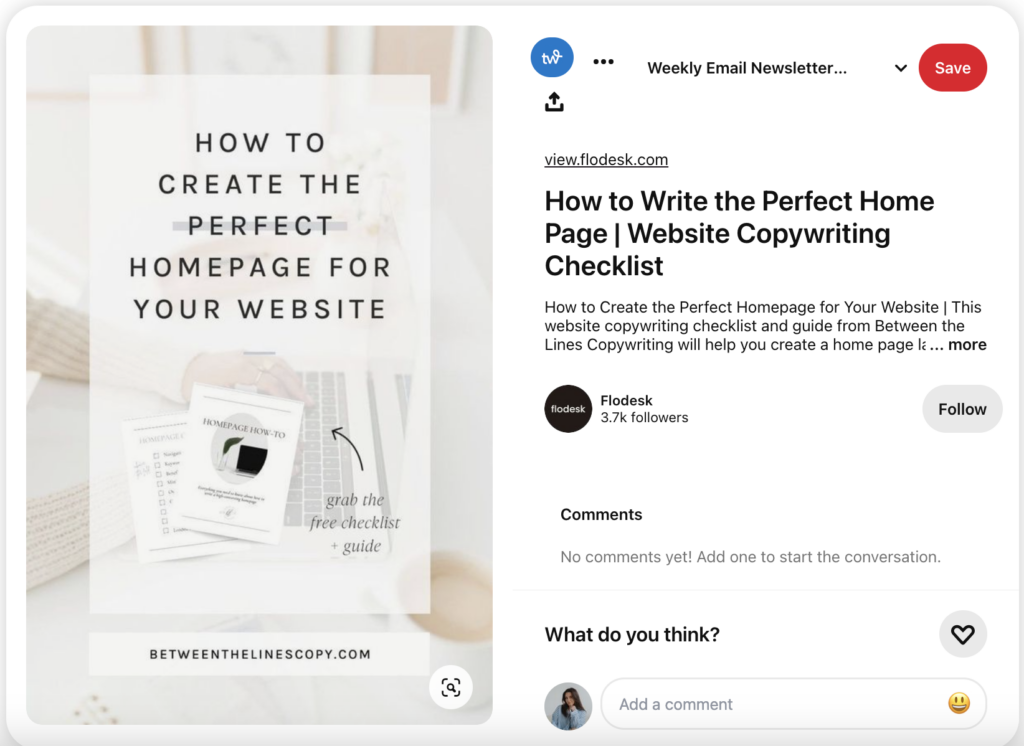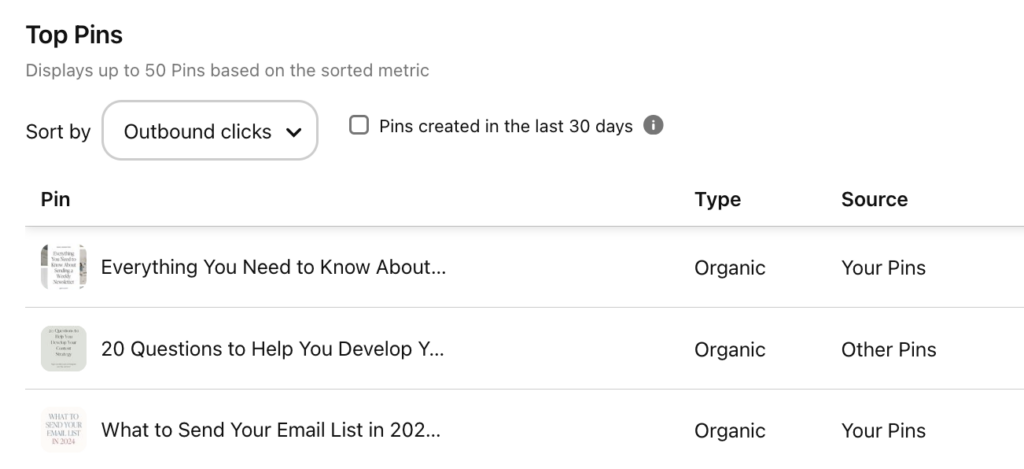Pinterest and email marketing are two of the best marketing channels for creative entrepreneurs. While each is powerful on its own, the real magic happens when you use Pinterest to grow your email list, putting Pinterest and email marketing together.
You may think of Pinterest as just a way to drive traffic or even just another social media channel, but Pinterest can be instrumental in growing your email list. In fact, I recommend anyone who wants to market on Pinterest also start building an email list and using email marketing actively.
But I’m getting ahead of myself.
If you want to learn how to use Pinterest to grow your email list, including Pinterest-approved freebie ideas, what you need to make your email list profitable, how to convert Pinterest traffic into subscribers, and more, you’re in the right place!
Why Your Email List Matters
If you aren’t using email marketing in your business yet, this is your sign to start. Email is one of the most profitable marketing platforms available and it’s much less volatile than other options like ads or social media.
No matter what your niche is or what you actually do, I can almost guarantee you will benefit from adding email to your marketing strategy.
And because I’m not gonna throw a bold claim like that out there without backing it up, here’s why:
Email marketing has a higher ROI
Your return on investment (ROI) is a helpful measure to determine if the money you’re spending is worth it.
The commonly reported stat is that email marketing averages an ROI of $42 for every $1 spent.
[Note: I wasn’t able to find the original statistic with a current publish date, just a lot of blogs linking to other blogs. The true number might be slightly different, but the overall takeaway is the same!]
This is a much higher ROI than from social media marketing, and there’s evidence to say consumers spend more from email marketing than from similar content on social media.
You have more ownership of your email list
You’ve seen it before. Instagram goes down for a day and when it’s back, all the email marketers are telling you “See, this is why it’s important to have an email list!”.
Although I don’t love this as a marketing tactic, they are right. You have probably the least control over social media platforms like Instagram, TikTok, and LinkedIn. If your account got hacked or the site crashed, you could lose all of the momentum you had there.
Imagine building your business solely on Instagram and then it vanishes. How would you reach your previous followers? How would you continue to sell?
Email marketing offers slightly more stability.
I won’t tell you it’s foolproof or that you “own” your email, because you don’t. Your email service provider is nearly just as likely to have an outage or an issue. The best thing you can do to safeguard against this is to semi-regularly export a CSV of your subscribers.
Your email list is full of warm, ready-to-buy subscribers
Opting into your email list is a form of microconversion. Those subscribers trusted you enough to give you their email and invite you into their inbox. They’ve already “bought in” to you once, which makes them more likely to purchase from you or hire you in the future.
Email marketing helps increase your ROI from Pinterest
The question of what kind of returns on investment you can get from Pinterest is one I don’t typically answer. That’s because the answer depends on so many individual factors that I can’t (and won’t) give a generic estimate just to “sell you” on Pinterest marketing.
That being said, something that typically helps increase your ROI from Pinterest marketing is growing and nurturing your email list. Having an active email list and email marketing strategy helps turn your Pinterest traffic from one-time visitors to loyal members of your audience. And as we just learned, those loyal audience members are more likely to invest in you.
Why You Should Use Pinterest for Your Email Marketing
A lot of online business owners have already heard the whole email marketing song and dance. That’s great! What they often overlook, however, is how they could be using email even better with the help of Pinterest marketing. Here’s how:
Pinterest will help you reach new audiences
If you want your email marketing to be effective, you need to actually have people on your email list to sell to. The biggest benefit of Pinterest for email marketing is that Pinterest can help you grow your email list to new audiences.
Unless you’re really hustling on social media and bringing in slews of new followers, you’re inherently going to be a bit limited in your potential to grow your email list. Not only that, but by only promoting your email list on social media, you could be missing out on entire groups of people that just aren’t on there.
The way the Pinterest algorithm works depends less on your following and more on users’ search and activity. That means you have a greater potential to reach more brand new audiences when you use Pinterest to grow your email list!
Use Pinterest to grow your email list with more qualified subscribers
Because the Pinterest algorithm is so strongly weighted towards users’ current interests, it’s great at connecting users with the exact content they want to see. This works to your benefit as a business owner using Pinterest to grow your email list, as you know subscribers from Pinterest are more likely to be specifically interested in your opt-in and/or content.
Most Pinterest users are browsing with intent. They have a current problem that they’re looking for the solution to, so if your freebie promises to solve that problem, you have a more active and engaged email subscriber!
You can test new ideas
Pinterest is a fabulous testing ground for content and ideas. Since every piece of content stands alone and could get distributed differently, you can test whatever you like without worrying about too much audience confusion.
This is especially helpful when it comes to using Pinterest to grow your email list because you can test a new freebie or piece of content with a new-to-you Pinterest audience, without having to let your following on other platforms know what’s going on behind the scenes.
7 Steps to Use Pinterest to Grow Your Email List
If you want to grow your email list with Pinterest, here’s a high-level overview of what you need to do:
- Develop an opt-in offer that gives people a reason to subscribe
- Write a welcome sequence that nurtures your list
- Build your Pinterest foundations
- Publish pins linking to your freebie
- Optimize your existing content for email list growth
- Create new content around the topic of your freebie
- Promote your freebie-related content on Pinterest
Now let’s break it down even further and see how to do all those things!
1. Develop an opt-in offer to grow your email list
I need you to know this — if you want people to join your email list, you need to give them a reason.
There’s been a lot of talk online about whether or not lead magnets are “dead,” and wherever you fall in that debate, you still need to make your email list sound worthwhile.
In other words, no more “Join the List” or “Stay in the Know,” okay?
Particularly if your website visitors are brand new to you and your brand, they don’t have any reason to want to stay in the loop or get updates because they don’t know you yet.
Having some sort of free opt-in is going to be the most effective way to grow your email list with Pinterest. But it’s not enough to just have any old PDF and call it a day.
If you want to create an effective lead magnet — one that gets your ideal clients on your list and primed to hire you down the road — here are some things to think about:
- Consider what types of people you want to attract with your lead magnet
- What industry are they in?
- What stage of business are they in?
- What kinds of things are those people looking for before hiring you?
- What problems are they having?
- What questions are they searching on Google and Pinterest?
- What resource can you give that solves their immediate problem without giving away your “secret sauce”?
- It should be valuable enough to be worth trading for their email address, but not so valuable that they don’t need anything else from you ever again
Creating a lead magnet is a whole process and strategy of its own, but make sure you’re giving your audience a reason to join your email list that they actually want, is actually valuable, and actually aligns with the audience you want to have on your list.
2. Nurture new subscribers with a welcome sequence
Do. Not. Ghost. Your. List.
If someone has given you their email address and invited you into their inbox, that’s a valuable opportunity I don’t want you to waste! If all you’re doing is delivering the freebie and saying peace out, your email list isn’t actually going to be doing much for you.
A welcome sequence is essential to introduce new subscribers to you and your brand and, like the name implies, welcome them to the list.
Here’s a simple welcome sequence framework you can apply and use for your business:
- Deliver the freebie
- Follow up with an introduction
- Show off your expertise and sell
- Say thanks and close out the sequence
If you want to see this in action, my client Between the Lines Copywriting has a free email marketing formula you can grab!
3. Build your Pinterest foundations
Since we’re talking all about using Pinterest to grow your email list, we need to talk about the Pinterest of it all!
Starting from a strong foundation with your Pinterest marketing will mean you can spend more time fine-tuning your Pinterest content instead of worrying if you have the basics correct.
The two most important components of a strong Pinterest foundation are:
- Keyword research
- Profile optimization
Before optimizing your profile, it’s essential to conduct at least some preliminary keyword research to get a good sense of the keywords you’ll be using for all of your content. When pinning about your email list or, more accurately, your email list opt-in, you’ll also want to do Pinterest keyword research specifically for that topic.
The easiest way to find your Pinterest keywords is to start typing the topic into the search bar and see what suggested searches auto-populate. Those terms will be the long-tail keywords you want to use in your pins.
Optimizing Your Profile
Your Pinterest profile should be complete and keyword-rich. Not sure if yours meets the standard? Here’s a quick checklist:
- Descriptive profile title with at least one keyword
- Thorough bio explaining what users can expect to find in your content
- Branded profile and header pic
- Claimed domain
- A variety of relevant, SEO-optimized boards
4. Publish pins linking to your freebie
Now that your Pinterest account is set up and ready to be pinned to, it’s time to start pinning to your freebie! This tends to be an overlooked step when growing your email list with Pinterest.
The common misconception is that you can only pin to blog posts. And while I do recommend having a blog if you’re going to be marketing on Pinterest, you should also be pinning directly to your lead magnets!
If you want to use Pinterest to grow your email list, the best thing to do is create a landing page on your own website that you can pin to.
Many email service providers have their own landing page builders and opt-in forms, but unless you’re able to claim the subdomain of those forms — and on most of them, you can’t — those pins won’t perform as well.
Having your lead magnet landing page on your own website before pinning to it tells Pinterest that you “own” the content. With Pinterest prioritizing original content, this is important! It also makes sure that when the pins are published, your account shows up as the pin creator, not Flodesk’s.

Beyond having the opt-in be on your claimed domain for Pinterest’s sake, there are a lot of other benefits to having a lead magnet landing page hosted on your own website.
5. Optimize your existing content for email list growth
Remember how I said you should be blogging if you’re Pinterest marketing? Yeah, this is where that comes in!
Blog posts are the expectation for Pinterest users. They understand that if they click through a pin, they’re likely going to find some kind of long-form content answering their question.
If you’ve already been blogging and pinning your blogs to Pinterest, this is a great opportunity to grow your email list through Pinterest without too much extra effort!
Depending on the topic of your freebie, go back through your current blog posts and see if there are any that are relevant that you could plug your freebie in. Your blogs should already have a call to action of some kind, but if your main priority is growing your email list, consider switching out your current CTA to one that promotes your lead magnet.
Auditing your old content can be quite the task, especially if you have a lot of blog posts. If this is the case, take a look at your Pinterest analytics and even Google analytics to help you prioritize the order of updates.
In your Pinterest analytics dashboard, you can sort your top pins by the number of outbound clicks they’re getting. Look through those and if there are any blog posts that stand out as sending a lot of traffic, prioritize updating those with relevant, compelling calls to action to your email list.

When promoting your freebie, look for opportunities beyond just the blog’s conclusion to add in a CTA. Not every Pinterest user landing on your site is going to read the whole blog, so add in a mid-scroll CTA or even an image that links to the opt-in page to capture their attention!
6. Create new content around the topic of your freebie
It’s possible that you might not have any existing content that’s relevant to your freebie topic. Whether or not that’s the case, it will benefit you to create new blogs specifically with the intention of driving email sign-ups.
For example, if I wanted to increase downloads of my Pinterest Blueprint, I could write a blog all about how to get started with Pinterest marketing. The blog itself has enough information to be valuable, but I would also make sure to point readers to the freebie if they want a more in-depth guide.
Finding the balance between free content and free-for-email content is tricky, I’ll give you that, but try not to overthink it!
7. Promote your freebie-related content on Pinterest
The last step to use Pinterest to grow your email list is creating a Pinterest content strategy that prioritizes email list growth. This looks like pinning mostly content related to your freebie, both to the landing page directly and to those old and new blog posts that we’ve just optimized for email subscribers.
The Pinterest algorithm is constantly seeking to understand you and your content so that it can serve it to the users who are interested in it. By keeping your content narrowly focused on the topic of your freebie, you’ll see faster growth in those specific searches.
You don’t have to just pin to the freebie or the blogs promoting the freebie, but if you have enough content to make it about a 80:20 split, that would be amazing!
Pinterest is the best way to passively grow your email list
An important caveat: nothing is truly passive when it comes to marketing, unless you’re outsourcing it entirely.
However, if you create pins for your email list and schedule them to go out over time, you’ll see email subscribers roll in consistently without having to constantly shout about it on social media.
If you ask me, or if you ask my clients, using Pinterest to grow your email list is one of the best functions of Pinterest marketing. That’s because from your email list, you have a greater potential to connect, sell, and convert.
Speaking of email lists… I’m currently in the middle of a series in my newsletter, the Thursday Press, all about growing your subscribers with Pinterest, and I save all my best info for my subscribers. Wanna get in on the action? Subscribe here!
